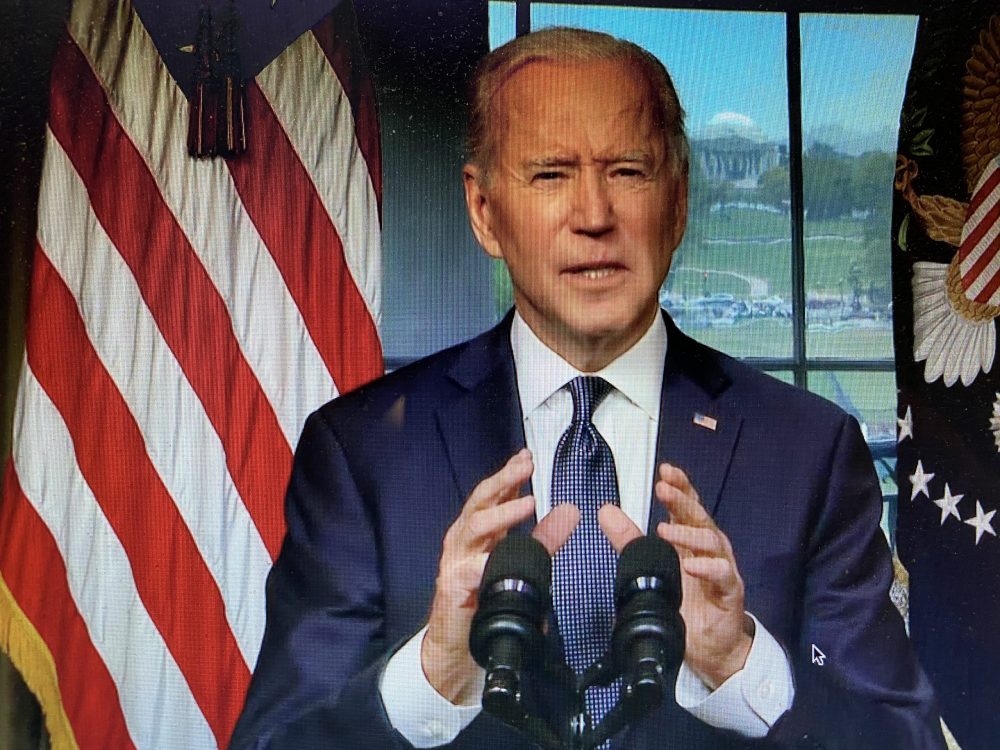President Joe Biden announced Wednesday he will begin withdrawing U.S. troops from Afghanistan on May 1, completing a full withdrawal by Sept. 11, the 20th anniversary of the 2001 terrorist attacks.
“I’m now the fourth United States president to preside over American troop presence in Afghanistan. Two Republicans, two Democrats. I will not pass this responsibility on to a fifth,” Biden said Wednesday during a televised speech in the White House’s Treaty Room. “I’ve concluded it’s time to end America’s longest war. It’s time for American troops to come home.”
He added that the United States would “not take our eye off the terrorist threat” in Afghanistan or anywhere else following the withdrawal.
“We will reorganize our counter-terrorism capabilities and the substantial assets in the region to prevent the re-emergence of terrorist threat to our homeland over the horizon,” Biden pledged. “We’ll hold the Taliban accountable for its commitment not to allow any terrorist to threaten the United States or its allies on Afghan soil. The Afghan government has made that commitment to us as well, and we’ll focus our full attention on the threat we face today.”
Biden said the reasons for keeping U.S. troops in Afghanistan are becoming “increasingly unclear” and that since he visited the country as vice president, he has believed that only “the Afghans have the right and responsibility to lead their country.”
The president said “significant humanitarian and development assistance” will be maintained in order to protect Afghan women.
Biden had been facing a May 1 withdrawal deadline negotiated in Doha, Qatar, last year by the Trump administration with the Taliban.
Administration officials have said the withdrawal effort will be coordinated between the United States and North Atlantic Treaty Organization (NATO) allies and will not be conditions-based.
Biden’s September withdrawal has been met with objections from some top leaders in the Pentagon and the intelligence community, who warned U.S.-backed local forces won’t be able to withstand Taliban violence without certain capabilities provided by the Americans.
Biden’s move drew both criticism and praise from Capitol Hill.
Senate Minority Leader Mitch McConnell, R-Kentucky, attacked the decision on the Senate floor Wednesday, saying Biden was taking “the easy way out of Afghanistan” and the likely result would be “disaster.”
“If this administration wants a successful legacy on the world stage, if they want accomplishments that will endure, they need to put American strength back at the center and come back to the bipartisan mainstream,” McConnell said.
Sen. Lindsey Graham, R-South Carolina, told reporters that terrorist groups must be jubilant: “In their world, they beat us.”
There should be a residual U.S. force in Afghanistan, he said. By ignoring that advice from various experts, he told the president “this is on you, this is not on the military.”
But Sen. Ted Cruz, R-Texas, said leaving Afghanistan “should not be taken as a sign that America will be any less vigilant in protecting American lives and those of our allies, but we can do so without a permanent military presence in a hostile terrain.”
House Speaker Nancy Pelosi, D-California, said the withdrawal was “an important and welcomed development.”
“I support this transition and President Biden’s leadership to protect the safety of our troops and the security of the American people, which must be our priority,” Pelosi said in a statement.
House Majority Leader Steny Hoyer, D-Mechanicsville, said the withdrawal is “the right decision.”
“More than 2,300 American service-members and more than a thousand serving in allied Coalition forces made the ultimate sacrifice in Afghanistan,” the Maryland lawmaker said. “The previous approach of maintaining thousands of U.S. military personnel in Afghanistan has not led to a resolution, and a new approach is required.”
The chairman of the House Armed Services Committee, Rep. Adam Smith, D-Washington, said he concurred with Biden “that we cannot wait for the perfect security conditions before withdrawing – to do so would mean our men and women in uniform would never return home.”
“Our goal in the region,” Smith said in a statement, “has always been to prevent transnational terrorists from launching an attack against the United States or our allies, but there are other means to monitor that threat and manage risk and, at this point, the cost and risk of a continued troop presence – both US troops and those of our allies – outweigh the benefits.”
There are officially 2,500 U.S. troops currently in Afghanistan as well as 1,000 more special operations forces. There are also up to an additional 7,000 foreign forces there, the majority of them NATO troops.
Then-President George W. Bush deployed the first U.S. soldiers to Afghanistan shortly after the 2001 terrorist attacks. Biden said he spoke to his predecessor on Tuesday.
“While he and I have had many disagreements over policy throughout the years, we’re absolutely united in our respect and support to the valor, courage and integrity of the women and men of the United States armed forces who have served,” Biden said.

